Court Line
Court Line Aviation was a prominent British holiday charter airline during the early 1970s based at Luton Airport in Bedfordshire. It also provided bus services in Luton and surrounding areas.
| |||||||
| Founded | 1957 (as Argus Air Transport) | ||||||
|---|---|---|---|---|---|---|---|
| Ceased operations | 1974 | ||||||
| Hubs | London Luton Airport | ||||||
| Fleet size | 14 aircraft (2 Lockheed L-1011 TriStar-1, 9 BAC One-Eleven 500, 1 Hawker Siddeley HS 125, 1 Bell JetRanger, 1 Cameron 0-84 Balloon) as of March 1974 | ||||||
| Destinations | worldwide | ||||||
| Headquarters | Central London (1957–1970) London Luton Airport (1970–1974) | ||||||
| Key people | John R. Young, Edward J. Posey, G.H.G. Threlfall, W.H. Armstrong | ||||||
It helped pioneer the concept of "cheap and cheerful" package tours to Spain and other destinations in the "Med" in conjunction with Clarksons Holidays, thus taking part in the establishment of a whole new way of holidaymaking for the British public.
The airline, its parent company and its subsidiary tour operators, Clarksons Travel Group and Horizon Travel, ceased trading on 15 August 1974, with at least £7 million owing to 100,000 holidaymakers.[1][2]
History
Autair
The airline, originally named Argus Air Transport, was formed at London Luton Airport in 1957.[2][3][4] In 1960, it became Autair (Luton). On 27 September 1963, it changed to Autair International Airways.[5]
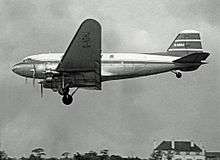
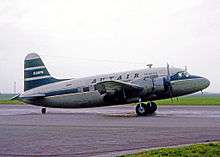
Autair started as a division of Autair Helicopters, a helicopter operator established in the early 1950s.[5][6][7][8] (Autair's helicopter interests were subsequently hived off into a separate company.[2][8]) It began public transport operations with an ex-British European Airways (BEA) Douglas DC-3,[9] used on contract work for other airlines.[5][6][10] More DC-3s and Vickers Vikings[11] were bought. The first of the latter joined the fleet in 1962. Both types operated freight and passenger services, including a growing number of inclusive tour (IT) flights.
One of the earliest charter customers for Autair's DC-3s was ex-naval officer Tom Gullick,[12] who would later head Clarksons. Clarksons began its relationship with Autair by contracting the airline's Vikings to ferry day-trippers between up to ten UK departure points and Rotterdam during the Dutch bulbfield season.[1][13][10] Airspeed Ambassadors[14] and a leased Handley Page Herald[15] were introduced in 1963. The former were the airline's first pressurised aircraft while the latter was its first turboprop.[5][6]
On 1 October 1963, the airline commenced scheduled services between Blackpool and Luton with Vikings.[1][5][10][16] The route was subsequently operated with Ambassadors and extended to Glasgow on 24 May 1966.[17]
In the following years, all piston-engined aircraft types were withdrawn and replaced with Hawker Siddeley 748[18] and Handley Page Herald turboprops. Three Heralds operated the company's scheduled services, including the main London—Teesside route.[10][19][20][21]
1964 saw the formation of Clarksons Tours (later, Clarksons Holidays) with Tom Gullick as managing director. Over the next few years, Clarksons would become Autair's and its successor Court Line's most important tour operator customer.[10][22]
In April 1965, Court Line—a shipping company that could trace its history back to 1905[12]—purchased Autair's entire share capital for £215,000.[1][8][12][23][24]
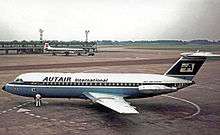
Autair became a jet operator in 1968, when three brand-new BAC One-Eleven 400 series[25][26] joined its fleet. The new jets mainly operated IT flights.[10][19][27][28][29]
1968 was also the year Clarkson's customer base had grown to 175,000 (up from 4,000 in 1964[30]), many of whom flew to their holiday destination on Autair's new jets.[31]
By spring 1969, five One-Eleven 400s (including an example acquired second-hand from Channel Airways[32]) operated Autair's IT flights, primarily under contract to Clarksons Tours.[7][10][19][27][28][29][33] These carried the bulk of the airline's half-a-million annual charter passengers, which far outnumbered the 66,000 using its scheduled services each year.[12]
From 1 April 1969, the airline's scheduled operation in London was consolidated at Heathrow, joining Teesside services which had already transferred to London's premier airport from the company's Luton base on 1 November 1967.[34][35]
In summer 1969, Autair announced its decision to withdraw all scheduled services "irrevocably", following an unsuccessful request for government subsidies. By that time, the airline's scheduled network served Belfast, Blackpool, Carlisle, the Channel Islands, Dundee, Glasgow, Hull, the Isle of Man, London and Teesside in the UK, Dublin in the Republic of Ireland and Amsterdam in the Netherlands. Scheduled services accounted for 12% of Autair's turnover. The airline's scheduled operation was estimated to have generated an annual loss of £150,000 (only London—Teesside was said to be profitable).[8][10][16][19][20][36]
On 31 October 1969, scheduled services were stopped and all turboprop aircraft sold.[36] This was followed by an order for seven of the larger 119-seat 500 series One-Eleven.[12][27][29][37][38]
Court Line Aviation
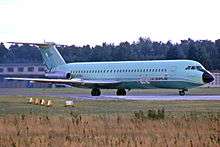
To coincide with the arrival of the first BAC One-Eleven 500, the airline changed its name on 1 January 1970 to Court Line Aviation and introduced a new corporate look and strategy that focused exclusively on the then fast-growing package holiday market.[2][8][12][16][39] As the larger One-Eleven 500s were delivered, all but one of the smaller, former Autair 400 series One-Elevens were retired.[10][39][40]
The corporate look was an all-over colour design by Peter Murdoch. In keeping with the holiday "feel-good factor", One-Elevens were painted in the following distinctive, eye-catching pastel colour combinations: yellow/gold/orange,[41] pink/rose/magenta,[42] pale violet/mauve/purple,[43] light green/mid-green/forest green.[44] These were named Halcyon Skies. Aircrew wore trendy uniforms designed by Mary Quant. This was part of making passengers feel that the flight was a "fun part" of their holiday.[1][8][12][39][45] For many, it would be their first flying experience.
Other airlines and tour operators were quick to jump on the burgeoning package holiday bandwagon. This resulted in increasingly fierce competition between operators and led to a price warfare to fill planes and hotels. Under Tom Gullick's management, Shipping Industrial Holdings subsidiary Clarksons Holidays became the undisputed cut-price leader in the IT market. By 1973, Clarksons carried 1.1 million holidaymakers—almost 1968's whole industry total—and contracted over 70% of Court Line's charter capacity. Its meteoric rise was entirely volume-based. It generated the required volumes by ruthlessly undercutting rivals and outbidding them to win the race for securing accommodation in popular overseas holiday resorts, especially in Spain.[10][12][31][46] Thus, in the early 1970s, a holiday in Majorca or on the Costa del Sol became affordable for the average person for the first time.[1]
Court Line and Clarksons Holidays were also a UK pioneers of the "time charter" concept, whereby the airline entered into a long-term relationship with the tour operator. "Time charter" was modelled on similar long-term arrangements between ship owners and charterers in the oil tanker business. It resulted in greater economic security for the charter airline industry and enabled it to acquire new aircraft on more favourable terms.[12]
"Seat-back" catering
Court Line invented "seat-back" catering, a new concept that permitted a reduction in the amount of galley space inside its aircraft's cabins. The extra space obtained was equivalent to three seats on the One-Eleven 400. This enabled it to increase seating densities and reduce individual seat rates to allow tour operators to hold on to their market shares in a price-sensitive environment.[10][47][48]
The concept itself consisted of pre-packed meals or snacks – usually, Spam salads out and sandwiches back[49] — loaded into a small, two-shelf compartment in the seat back in front of each passenger. The meal/snack for the outbound journey could be found in the top compartment, the one for the return trip in the lower section. The latter contained a pellet of dry ice placed under the plastic food container, thus preventing the food from spoiling. For the airline's cabin staff, it eliminated handling trays while airborne and resulted in a reduction of their workload. To prevent outbound passengers from consuming meals intended for return passengers, locks needed to be installed on the lower compartment that could only be opened by cabin staff during the aircraft's turnaround at the destination airport (although these were not always effective at deterring determined passengers).[40][48][50][51]
In addition to Court Line/Clarksons, Great Universal Stores (GUS) subsidiary Global was a major proponent of "seat-back" catering among the UK's leading contemporary tour operators. It demanded that package holiday costs be driven down to the bare minimum by replacing the traditional meal service on holiday charter flights with something much cheaper that would simply give passengers "a slice of pie". Industry insiders referred to Global's new inflight catering concept as Global Pie. The cost advantage industry leaders such as Court Line/Clarksons and Global gained over their rivals as a result of their onboard catering innovation eventually forced every other major UK charter airline to adopt "seat-back" catering on most flights serving short- and medium-haul IT destinations.[52]
Widebody era
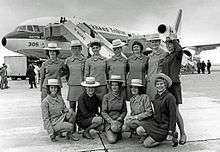
In 1973, Court Line took delivery of a pair of Lockheed L-1011 Tristars[53][54] and became the first European airline to operate the Lockheed widebody.[2][3][45][55][56][57][58] The aircraft were acquired on long-term lease from Airlease International, a consortium of eleven British banks and financial institutions. They were uniquely customised for Court with double-width doors to speed up passenger evacuation and featured integral passenger stairs and baggage conveyors to facilitate operations at smaller airports.[30] The introduction of these brand-new widebodies was a big gamble for a small airline operating in a seasonal market with tight margins as the new jets had four times the One-Eleven's passenger capacity (476 vs 119).
Court took the view with Clarksons that the market would grow and that such large aircraft could be operated profitably. In addition, Clarksons was looking to expand further into cruise holidays and new markets in the US and the Caribbean.[1][45][57] This, at the time, was wholly new territory for the UK package tour market.
The acquisition of Leeward Islands Air Transport (LIAT), a regional airline based in the Caribbean, in 1972 was part of Court's long-haul expansion strategy.[59] Court Line provided LIAT with BAC One-Eleven series 500 aircraft for scheduled passenger services in the Caribbean. The BAC One-Eleven was the only jet aircraft type ever operated by LIAT.
The introduction of the TriStar led to an increase in maintenance personnel and the modification of an existing hangar at the airline's Luton base to accommodate the new widebody. It also resulted in the purchase of a former Royal Air Force Blackburn Beverley cargo transporter from the Royal Aircraft Establishment to airlift Rolls-Royce RB211 replacement engines and/or other essential spares in case the planes developed a serious technical fault at an overseas station that prevented them from returning to Luton (although in fact the Beverley was never civil registered and so was never used).[45][57][58]
The airline's total investment in widebodied equipment amounted to US$55 million.[30]
Hard times
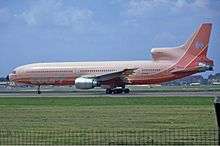
As early as 1971, Clarksons lost as much as £2.6 million despite increasing its turnover by £9 million to £31 million. Industry sources estimated that this equated to a loss of £4 per head.[60]
In 1972, Clarksons's loss grew to £4.8 million. This was almost 2½ times as much as the combined loss of Thomson Holidays (£1.6 million) and Horizon Holidays (£388,000), its closest rivals.[61]
By 1973, Clarksons carried over a million passengers and accounted for 40% of Court Line's turnover.[30]
During the 1973–74 winter season, Clarksons's plight worsened. At the time, the UK was in the grip of a recession, as a result of the early 1970s energy crisis caused by the Organization of Petroleum Exporting Countries' oil boycott of the West in the aftermath of the 1973 Arab–Israeli War. This was a punitive measure directed against these countries for their support of Israel during that war. It led to a drastic reduction in the availability of petroleum products – including jet fuel. This in turn resulted in a tripling of the oil price in October 1973 and a subsequent quadrupling.[62]
1974 became known as the worst year for the UK package tour industry. At the beginning of the year, Britain plunged into the three-day working week, as a consequence of the miners' strike that had been called to topple the Heath Government. This immediately reduced package holiday bookings by 30%. Clarksons, Court Line's main customer and in-house tour operator since April 1973, was facing mounting financial pressure, and Vladimir Raitz's Horizon Holidays, another of the airline's major customers, collapsed during that time. Following Court Line's takeover of Clarksons the previous year for a nominal £1 (excluding a £3.4 million "subsidy" from the airline's parent company to cover the tour operator's projected 1973 loss), it purchased the Horizon group's goodwill for £600,000—including the acquisition of 58% of Horizon Midlands for £400,000—from the administrator. The deal, which became effective in February 1974, was based on payment of £1 for each Horizon customer Court Line expected to carry over the following three years. The airline's decision to purchase Clarksons as well as Horizon was intended to protect its business. In reality, these deals did little to help improve Court Line's increasingly bleak prospects.
As soon as Court Line began diverting Horizon customers onto its planes, British Caledonian (BCal) threatened having Horizon compulsorily wound up if Court Line did not agree to settle Horizon's outstanding debts of over £100,000. BCal's threat forced Court Line to sub-charter a fully crewed BCal One-Eleven jet for Horizon's flying programme and to provide it with additional business. In addition to BCal forcing Court Line to compensate it for the loss of Horizon's business, Thomas Cook's money-back guarantee – a scheme widely copied by other rival tour operators – further reduced the number of Horizon holidaymakers travelling on Court Line's jets. As a result, Court Line carried far fewer Horizon customers than it had anticipated.[2][22][38][63][64][65][66] Clarksons's financial position further deteriorated. In a desperate attempt to fill the group's planes and hotel rooms so that it could stay afloat, Clarksons continued selling holiday packages below cost, with a fortnight all-inclusive holiday to Majorca selling for as little as £50.[1][2][63][67][68]
Bankruptcy
A deal between the Court Line group and the Wilson Government to sell the former's shipyards at Appledore, Devon and Sunderland to the latter for £60 million turned out to be "too little too late" to stave off the company's impending collapse.[69]
On 15 August 1974, Court Line went bankrupt, with all flights cancelled, its fleet comprising two TriStars and nine One-Eleven 500s grounded, all 1,150 staff losing their jobs and as many as 49,000 holidaymakers stranded overseas with no means of getting home. To enable stranded holidaymakers to return to the UK at no additional cost to them, the collapsed group's rivals organised an airlift through the Tour Operators' Study Group (TOSG), the package holiday industry association.[2][4][68][70][71] This operation was paid for using the £3.5m bond the failed group's tour operators had deposited with TOSG.[72]
The Association of British Travel Agents (ABTA) set up a fund to provide an insurance against such an event in the future. This was a compulsory bonding scheme for travel companies that transported their customers by air. It was administered by TOSG.[68]
On 16 August 1974, all of the group's UK-based subsidiaries went into voluntary liquidation. This included Court Line Aviation and Clarksons Holidays.[73]
Leeward Islands Air Transport (LIAT) in the Caribbean as well as South Africa-based Court Line Helicopters were among Court Line's overseas subsidiaries. Both survived the UK parent company's collapse.[2][45][57][73] LIAT subsequently withdrew the BAC One-Eleven series 500 aircraft from its fleet which had been provided by Court Line.
The Court Line Coaches subsidiary, although itself solvent and having most of its work from sources other than Court Line Aviation, was wound up shortly afterwards. Commercial Motor of 23 August 1974 noted that "Court Line's coach fleet continues operations 'for the present' A go ahead to stay in operation has been given to Court Line Coaches Ltd by Mr Rupert Nicholson, who has been appointed to wind up the Court Line holiday giant which collapsed last week. Court Line Coaches has a fleet of 59 coaches and its managing director Mr Ron Keech told CM on Tuesday that the company has been told it could continue trading. He had however, "no idea" what might happen in a few months' time."
Factors behind collapse
In addition to the early-'70s oil crisis and the three-day week, there were other factors that had caused the collapse of the group of companies that included Court Line and Clarksons.
One of these factors was the parent company's precariously highly geared investment in the shipping and leisure industry sectors.
According to some insider reports at the time, Court Line Aviation was a viable business. However, a proposed management buyout was rejected as its liquidation value was needed to pay off the parent company's debts.
The Department of Trade and Industry final report into the Court Line collapse concludes:
"The short answer is that there was no single reason for the collapse, which was caused by a number of contributory factors. Court Line expanded rapidly in many directions, some of which were both logical and justifiable, others not. The overall management was throughout inadequate and it was in any event never supported by the necessary financial control. This meant that as Court Line expanded, it became progressively vulnerable to any substantial setback in any of its areas of activities. When a serious setback occurred, triggered off by the oil crisis of autumn 1973, it immediately affected the shipping, aviation, and leisure divisions. The group was so highly geared, so structured and having such inadequate financial control, that it might well have been brought down by a substantial reverse in any of its major activities. As it was the cumulative effect on all three divisions, when all the cash resources which would otherwise have been available had been invested unprofitably in the Caribbean, meant that the position progressively deteriorated and rendered the collapse in August 1974 unavoidable."
Disposal of airline's assets
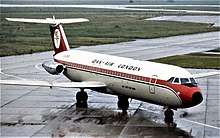
Following the spectacular crash of Court Line and Clarksons at the height of the 1974 holiday season, the failed carrier's fairly new aircraft were acquired by other airlines. Cathay Pacific took the L-1011 TriStar widebodies while Dan-Air and Monarch Airlines respectively purchased four and two of the One-Eleven 500 narrowbodies. These aircraft needed to be re-registered to avoid having them impounded by overseas airport authorities in lieu of the airport user charges Court Line owed them.[75][76][77][78]
Fixed-wing aircraft operated
Autair
Court Line
Fleet and employee data
1970
| Aircraft | Number |
|---|---|
| BAC One-Eleven 500 | 7 |
| BAC One-Eleven 400 | 1 |
| Bell JetRanger | 1 |
| Total | 9 |
Court Line employed 670 people at that time (as of March 1970).[80]
1974
| Aircraft | Number |
|---|---|
| Lockheed L-1011 TriStar 1 | 2 |
| BAC One-Eleven 500 | 9 |
| Hawker Siddeley HS 125 | 1 |
| Bell JetRanger | 1 |
| Cameron 0-84 Balloon | 1 |
| Total | 14 |
Court Line employed 1,150 people at that time (as of March 1974).[4]
Accidents and incidents
Autair suffered two accidents, one of which involved the loss of lives.[81]
- The first of these occurred on 14 September 1967. One of the airline's Ambassadors (registration: G-ALZS[82]) overran the runway at Luton Airport at the end of a non-scheduled passenger flight from Luxembourg. The aircraft had approached Luton in darkness. Visibility was 5,900 ft (1,800 m) and the cloud base 300 ft (91 m). Following touchdown, the pilot in command retracted the aircraft's flaps in the takeoff position and applied brakes intermittently. The aircraft overran the runway and came to a stop in soft clay. This caused the undercarriage to collapse. The aircraft was damaged beyond repair and had to be written off.[83] However, there were no fatalities among the 69 occupants (four crew and 65 passengers).[84]
- The second took place on 23 December 1967. A Hawker Siddeley HS 125 (registration: G-AVGW, owned by The Beecham Group and operated by Autair International) crashed shortly after taking off from Luton Airport, killing both pilots. The aircraft had been on a training flight and the crash occurred when the crew simulated an engine failure on takeoff. The HS 125 lost height rapidly and hit the roof of a nearby factory, resulting in a post-crash fire.[85]
- On 18 April 1974, BAC One-Eleven G-AXMJ was involved in a ground collision with Piper PA-23 Aztec G-AYDE during take-off from Luton Airport, Bedfordshire. The Aztec had entered the active runway without permission. The pilot of the Aztec was killed and his passenger was injured. The One-Eleven aborted its take-off and an emergency evacuation was performed with all 93 people on board escaping uninjured. The Aztec was written off and the substantially damaged One-Eleven was repaired and returned to service.[86]
- A Court Line BAC One-Eleven leased to Cyprus Airways was stranded in 1974 at Nicosia Airport following the Turkish invasion of Cyprus. It was retrieved by British Airways engineers in 1977, but was immediately impounded on its arrival in Britain by Court Line's insurers to help pay off the debts the now defunct company owed. The aircraft was returned to Cyprus Airways in 1978 and remained in service until 1985.[87]
Citations
- The Court failure, Flight International, 22 August 1974, editorial page
- The bubble bursts, Air Transport, Flight International, 22 August 1974, p. 198
- World Airline Survey, Flight International, 22 March 1973, p. 452
- World Airline Directory, Flight International, 21 March 1974, p. 31
- Blackpool—London, Air Commerce ..., Flight International, 10 October 1963, p. 601
- World Airline Survey, Flight International, 11 April 1963, p. 513
- Autair International Airways Ltd, Britain's Airline Industry — Company-by-company information on the scheduled and non-scheduled carriers, Flight International, 24 October 1968, p. 657
- Airline Profile: Number Thirty-Nine in the Series — Court Line, Flight International, 19 March 1970, p. 438
- Autair Douglas C-47A Skytrain G-AJIC (photo)
- Airline Profile: Number Thirty-Nine in the Series — Court Line, Flight International, 19 March 1970, p. 439
- Autair Vickers 614 Viking 1 G-AHPB (foreground) and G-AGRW (background) (photo)
- Aircraft (Gone but not forgotten ... COURT LINE), Vol 43, No 7, p. 37, Ian Allan Publishing, Hersham, July 2010
- Aeroplane — Airline of the month: Channel Airways, Vol. 112, No. 2867, pp. 6–7, Temple Press, London, 29 September 1966
- Autair Airspeed AS-57 Ambassador 2 G-ALZS (photo)
- Handley Page HPR-7 Herald 101 G-APWB (photo)
- High Risk: The Politics of the Air, Thomson, A., Sidgwick and Jackson, London, 1990, p. 249
- A fourth way to Glasgow, Air Transport, Flight International, 2 June 1966, p. 916
- Autair Hawker Siddeley HS-748 Srs 2A/225 (photo)
- World Airline Survey, Flight International, 10 April 1969, p. 561
- No Subsidy for Autair, Air Transport, Flight International, 7 August 1969, p. 192
- British Midland's double anniversary, Flight International, 6 May 1978, p. 1390
- "Clarksons — The heart of global shipping (Home > About us > History > 1950 > Diversification)". Archived from the original on 8 July 2011. Retrieved 14 April 2010.
- Shipping company buys Autair, Air Transport ..., Flight International, 22 April 1965, p. 629
- Autair control clarified, Air Transport ..., Flight International, 17 June 1965, p. 978
- Air Transport ..., Flight International, 22 February 1968, p. 252 (photo including caption)
- Autair BAC One-Eleven 416EK G-AWBL (photo)
- Aeroplane, Commercial continued — Autair International, Vol. 116, No. 2960, p. 8, Temple Press, London, 10 July 1968
- More One-Elevens for Autair, Air Transport, Flight International, 11 July 1968, p. 42
- £30 million holiday deal, Air Transport, Flight International, 22 May 1969, p. 815
- Aircraft (Gone but not forgotten ... COURT LINE), Vol 43, No 7, p. 38, Ian Allan Publishing, Hersham, July 2010
- Fly me, I'm Freddie!, Eglin, R. and Ritchie, B., Weidenfeld and Nicolson, London, 1980, p. 124
- Classic Airliner (The BAC One-Eleven — Britain's bus-stop jet: Service around the world), Kelsey Publishing, Cudham, UK, July 2013, p. 71
- Airline Profile: Number Thirty-Nine in the Series — Court Line, Flight International, 19 March 1970, p. 440
- Autair from Heathrow, Air Transport ..., Flight International, 7 September 1967, p. 359
- Luton to London, Flight International, Air Transport ..., 26 December 1968, p. 1052
- Autair out, BMA in, Air Transport ..., Flight International, 13 November 1969, p. 729
- Autair orders One-Eleven 500s, World News ..., Flight International, 17 October 1968, p. 596
- Fly me, I'm Freddie!, Eglin, R. and Ritchie, B., Weidenfeld and Nicolson, London, 1980, pp. 185/6
- Autair becomes Court, Air Transport ..., Flight International, 18 September 1969, p. 445
- Airline Profile: Number Thirty-Nine in the Series — Court Line, Flight International, 19 March 1970, p. 441
- Court Line BAC One-Eleven 518FG G-AYOR (photo)
- Court Line BAC One-Eleven 518FG G-AXMF (photo)
- Court Line BAC One-Eleven 518FG G-AZEC (Diecast Airplane Colour Scheme)
- Court Line BAC One-Eleven 518FG G-AXMJ (photo)
- Halcyon days for Court, Air Transport, Flight International, 5 April 1973, p. 540
- High Risk: The Politics of the Air, Thomson, A., Sidgwick and Jackson, London, 1990, pp. 249, 295, 299
- High Risk: The Politics of the Air, Thomson, A., Sidgwick and Jackson, London, 1990, pp. 248/9
- Aircraft (Gone but not forgotten ... COURT LINE), Vol 43, No 7, pp. 37/8, Ian Allan Publishing, Hersham, July 2010
- It was nice to fly with friends! The story of Air Europe., Simons, G.A., GMS Enterprises, Peterborough, 1999, pp. 21/2
- High Risk: The Politics of the Air, Thomson, A., Sidgwick and Jackson, London, 1990, pp. 247/8
- Travel: Pioneering airlines set standards that today's carriers could only exceed The Independent, published 1995-05-01, accessed 2011-03-06
- High Risk: The Politics of the Air, Thomson, A., Sidgwick and Jackson, London, 1990, p. 247
- Court Line Lockheed L-1011-385-1 TriStar 1 G-BAAA (photo)
- Court Line Lockheed L-1011-385-1 TriStar 1 G-BAAB (photo)
- Tristar foot in Europe's door, Air Transport ..., Flight International, 4 November 1971, p. 719
- Court signs up, Air Transport, Flight International, 24 August 1972, p. 267
- Halcyon days for Court, Air Transport, Flight International, 5 April 1973, p. 539
- Halcyon days for Court, Air Transport, Flight International, 5 April 1973, p. 545
- Aircraft (Gone but not forgotten ... COURT LINE), Vol 43, No 7, p. 39, Ian Allan Publishing, Hersham, July 2010
- Fly me, I'm Freddie!, Eglin, R. and Ritchie, B., Weidenfeld and Nicolson, London, 1980, p. 183
- Fly me, I'm Freddie!, Eglin, R. and Ritchie, B., Weidenfeld and Nicolson, London, 1980, p. 182
- Fly me, I'm Freddie!, Eglin, R. and Ritchie, B., Weidenfeld and Nicolson, London, 1980, pp. 183, 185
- Clarksons bought by Court Line, Air Transport, Flight International, 3 May 1973, p. 664
- Court Line bids for Horizon, World News, Flight International, 7 February 1974, p. 158
- High Risk: The Politics of the Air, Thomson, A., Sidgwick and Jackson, London, 1990, pp. 294/5
- Aircraft (Gone but not forgotten ... COURT LINE), Vol 43, No 7, pp. 38/9, Ian Allan Publishing, Hersham, July 2010
- World's charter airlines, Flight International, 10 October 1974, p. 460
- High Risk: The Politics of the Air, Thomson, A., Sidgwick and Jackson, London, 1990, pp. 299
- Aircraft (Gone but not forgotten ... COURT LINE), Vol 43, No 7, pp. 37, 39, Ian Allan Publishing, Hersham, July 2010
- Bringing them back home, World News, Flight International, 22 August 1974, p. 197
- Aircraft (Gone but not forgotten ... COURT LINE), Vol 43, No 7, pp. 39, 40, Ian Allan Publishing, Hersham, July 2010
- Aircraft (Gone but not forgotten ... COURT LINE), Vol 43, No 7, p. 40, Ian Allan Publishing, Hersham, July 2010
- World Airline Directory, Flight International, 20 March 1975, p. 483
- Court Line Limited (Final Report), Department of Trade, HMSO, London, 1978
- Airliner Market, Air Transport, Flight International, 23 January 1975, p. 89
- Airliner Market, Air Transport, Flight International, 13 March 1975, p. 391
- BAC One-Eleven, Commercial Aircraft of the World, Flight International, 23 October 1975, p. 625
- The Spirit of Dan-Air, Simons, G.M., GMS Enterprises, Peterborough, 1993, pp88/9
- Court Line Piper PA-31-300 Turbo Navajo G-AYEI (photo)
- World Airlines 1970, Flight International, 26 March 1970, p. 479
- ASN Aviation Safety Database — Autair International Airways
- Autair Airspeed AS-57 Ambassador 2 G-ALZS (pre-accident photo)
- Autair Airspeed AS-57 Ambassador 2 G-ALZS (post-accident photo)
- ASN Aircraft accident description Airspeed AS.57 Ambassador 2 G-ALZS — London Luton Airport (LTN)
- ASN Aircraft accident description Hawker Siddeley HS.125-3B G-AVGW — London Luton Airport (LTN)
- "G-AXMJ Accident description". Aviation Safety Network. Retrieved 23 March 2011.
- Home of the BAC 1-11 on the Web > Enter > Country guide to operators > Rest of Europe — Cyprus: Cyprus Airways, Ltd. (CY)
References
- Simons, Graham M. (1997). Colours in the Sky: The Story of Autair International Airways and Court Line Aviation. Peterborough, UK: GMS Enterprises. ISBN 1-870384-55-5. External link in
|publisher=(help) - Merton Jones, A.C. (1976). British Independent Airlines since 1946. UK: Merseyside Aviation Society and LAAS International. ISBN 0-902420-08-9.
- "Flight International". Sutton, UK: Reed Business Information. ISSN 0015-3710. Cite journal requires
|journal=(help) (various backdated issues relating to Autair/Court Line, 1960–1974) - Eglin, Roger; Ritchie, Berry (1980). Fly me, I'm Freddie. London, UK: Weidenfeld and Nicolson. ISBN 0-297-77746-7.
- Thomson, Adam (1999). High Risk: The Politics of the Air. London, UK: Sidgwick and Jackson. ISBN 0-283-99599-8.
Further reading
- "Jets Monthly (Airline History — Courting DISASTER)". Cudham, UK: Kelsey Publishing Group. June 2011: 48–52. Cite journal requires
|journal=(help) (Kelsey Publishing Group online)
External links
| Wikimedia Commons has media related to Court Line. |